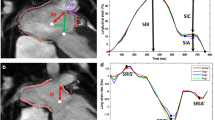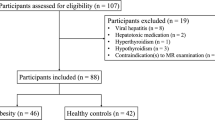Abstract
Objectives
To evaluate the left ventricular (LV) myocardial tissue characteristics in early adult obesity and its association with regional adipose tissue and ectopic fat deposition.
Methods
Forty-nine obese adults (mean body mass index: 29.9 ± 2.0 kg/m2) and 44 healthy controls were prospectively studied. LV native and post-contrast T1 values, extracellular volume fraction (ECV), regional adipose tissue (epicardial, visceral, and subcutaneous adipose tissue (EAT, VAT, and SAT)), and ectopic fat deposition (hepatic and pancreatic proton density fat fractions (H-PDFF and P-PDFF)) based on magnetic resonance imaging were compared. The association was assessed by multivariable linear regression.
Results
The obese participants showed reduced global ECV compared to the healthy controls (p < 0.05), but there was no significant difference in global native or post-contrast T1 values between the two groups. Additionally, the obese individuals exhibited higher EAT, VAT, SAT, H-PDFF, and P-PDFF than the controls (p < 0.05). ECV was associated with insulin resistance, dyslipidemia, and systolic blood pressure (SBP) (p < 0.05). Multiple linear regression demonstrated that H-PDFF and SAT were independently associated with ECV in entire population (β = − 0.123 and − 0.012; p < 0.05).
Conclusions
Reduced myocardial ECV in patients with mild-to-moderate obesity and its relationship to SBP may indicate that cardiomyocyte hypertrophy, rather than extracellular matrix expansion, is primarily responsible for myocardial tissue remodeling in early adult obesity. Our findings further imply that H-PDFF and SAT are linked with LV myocardial tissue remodeling in this cohort beyond the growth difference and cardiovascular risk factors.
Clinical trials registration
Effect of lifestyle intervention on metabolism of obese patients based on smart phone software (ChiCTR1900026476).
Clinical relevance statement
Myocardial fibrosis in severe obesity predicts poor prognosis. We showed that cardiomyocyte hypertrophy, not myocardial fibrosis, is the main myocardial tissue characteristic of early obesity. This finding raises the possibility that medical interventions, like weight loss, may prevent cardiac fibrosis.
Key Points
• Myocardial tissue characteristics in early adult obesity are unclear.
• Myocardial extracellular volume fraction (ECV) can be quantitatively evaluated using T1 mapping based on cardiac magnetic resonance imaging (MRI).
• Cardiac MRI-derived ECV may noninvasively evaluate myocardial tissue remodeling in early adult obesity.



Similar content being viewed by others
Abbreviations
- BMI:
-
Body mass index
- CO:
-
Cardiac output
- DBP:
-
Diastolic blood pressure
- EAT:
-
Epicardial adipose tissue
- ECV:
-
Extracellular volume fraction
- EDV:
-
End-diastolic volume
- EF:
-
Ejection fraction
- ESV:
-
End-systolic volume
- FFA:
-
Free fatty acid
- H-PDFF:
-
Hepatic proton density fat fraction
- HDL:
-
High-density lipoprotein
- HOMA-IR:
-
Homeostasis model assessment of insulin resistance
- LDL:
-
Low-density lipoprotein
- LV:
-
Left ventricular
- MRI:
-
Magnetic resonance imaging
- P-PDFF:
-
Pancreatic proton density fat fraction
- SAT:
-
Subcutaneous adipose tissue
- SBP:
-
Systolic blood pressure
- SV:
-
Stroke volume
- VAT:
-
Visceral adipose tissue
References
Yumuk V, Frühbeck G, Oppert JM, Woodward E, Toplak H (2014) An EASO position statement on multidisciplinary obesity management in adults. Obes Facts 7:96–101
WHO Expert Consultation (2004) Appropriate body-mass index for Asian populations and its implications for policy and intervention strategies. Lancet 363:157–163
Tian Y, Jiang C, Wang M et al (2016) BMI, leisure-time physical activity, and physical fitness in adults in China: results from a series of national surveys, 2000–14. Lancet Diabetes Endocrinol 4:487–497
Lavie CJ, Laddu D, Arena R, Ortega FB, Alpert MA, Kushner RF (2018) Healthy Weight and Obesity Prevention: JACC Health Promotion Series. J Am Coll Cardiol 72:1506–1531
Ren J, Wu NN, Wang S, Sowers JR, Zhang Y (2021) Obesity cardiomyopathy: evidence, mechanisms, and therapeutic implications. Physiol Rev 101:1745–1807
Kruszewska J, Cudnoch-Jedrzejewska A, Czarzasta K (2022) Remodeling and Fibrosis of the Cardiac Muscle in the Course of Obesity-Pathogenesis and Involvement of the Extracellular Matrix. Int J Mol Sci 23:4195
Murdolo G, Angeli F, Reboldi G et al (2015) Left ventricular hypertrophy and obesity: only a matter of fat? High Blood Press Cardiovasc Prev 22:29–41
de Simone G, Izzo R, De Luca N et al (2013) Left ventricular geometry in obesity: Is it what we expect? Nutr Metab Cardiovasc Dis 23:905–912
Schelbert EB, Testa SM, Meier CG et al (2011) Myocardial extravascular extracellular volume fraction measurement by gadolinium cardiovascular magnetic resonance in humans: slow infusion versus bolus. J Cardiovasc Magn Reson 13:16
Shah RV, Abbasi SA, Neilan TG et al (2013) Myocardial tissue remodeling in adolescent obesity. J Am Heart Assoc 2:e000279
Coelho-Filho OR, Mongeon FP, Mitchell R et al (2013) Role of transcytolemmal water-exchange in magnetic resonance measurements of diffuse myocardial fibrosis in hypertensive heart disease. Circ Cardiovasc Imaging 6:134–141
Bugianesi E, Gastaldelli (2012) A Hepatic and cardiac steatosis: are they coupled? Heart Fail Clin 8:663–670
Neeland IJ, Gupta S, Ayers CR et al (2013) Relation of regional fat distribution to left ventricular structure and function. Circ Cardiovasc Imaging 6:800–807
Pugliese NR, Paneni F, Mazzola M et al (2021) Impact of epicardial adipose tissue on cardiovascular haemodynamics, metabolic profile, and prognosis in heart failure. Eur J Heart Fail 23:1858–1871
Idilman IS, Yildiz AE, Karaosmanoglu AD et al (2022) Proton density fat fraction: magnetic resonance imaging applications beyond the liver. Diagn Interv Radiol 28:83–91
Marunowski K, Swieton D, Bzyl W et al (2021) MRI-Derived Subcutaneous and Visceral Adipose Tissue Reference Values for Children Aged 6 to Under 18 Years. Front Nutr 8:757274
Hong CW, Fazeli Dehkordy S, Hooker JC et al (2017) Fat Quantification in the Abdomen. Top Magn Reson Imaging 26:221–227
Chen Y, Peng Q, Yang Y et al (2019) The prevalence and increasing trends of overweight, general obesity, and abdominal obesity among Chinese adults: a repeated cross-sectional study. BMC Public Health 19:1293
Zhu L, Gu S, Wang Q et al (2020) Left ventricular myocardial deformation: a study on diastolic function in the Chinese male population and its relationship with fat distribution. Quant Imaging Med Surg 10:634–645
Liu J, Li J, Pu HX et al (2022) Cardiac remodeling and subclinical left ventricular dysfunction in adults with uncomplicated obesity: a cardiovascular magnetic resonance study. Quant Imaging Med Surg 12:2035–2050
Homsi R, Yuecel S, Schlesinger-Irsch U et al (2019) Epicardial fat, left ventricular strain, and T1-relaxation times in obese individuals with a normal ejection fraction. Acta Radiol 60:1251–1257
Kawel N, Nacif M, Zavodni A et al (2012) T1 mapping of the myocardium: intra-individual assessment of the effect of field strength, cardiac cycle and variation by myocardial region. J Cardiovasc Magn Reson 14:27
Haaf P, Garg P, Messroghli DR et al (2016) Cardiac T1 Mapping and Extracellular Volume (ECV) in clinical practice: a comprehensive review. J Cardiovasc Magn Reson 18:89
Moon JC, Messroghli DR, Kellman P et al (2013) Myocardial T1 mapping and extracellular volume quantification: a Society for Cardiovascular Magnetic Resonance (SCMR) and CMR Working Group of the European Society of Cardiology consensus statement. J Cardiovasc Magn Reson 15:92
Swoboda PP, McDiarmid AK, Erhayiem B et al (2016) Assessing Myocardial Extracellular Volume by T1 Mapping to Distinguish Hypertrophic Cardiomyopathy From Athlete’s Heart. J Am Coll Cardiol 67:2189–2190
Abel ED, Litwin SE, Sweeney G (2008) Cardiac remodeling in obesity. Physiol Rev 88:389–419
Buchanan J, Mazumder PK, Hu P et al (2005) Reduced cardiac efficiency and altered substrate metabolism precedes the onset of hyperglycemia and contractile dysfunction in two mouse models of insulin resistance and obesity. Endocrinology 146:5341–5349
Jung UJ, Choi MS (2014) Obesity and its metabolic complications: the role of adipokines and the relationship between obesity, inflammation, insulin resistance, dyslipidemia and nonalcoholic fatty liver disease. Int J Mol Sci 15:6184–6223
Peterson LR, Herrero P, Schechtman KB et al (2004) Effect of obesity and insulin resistance on myocardial substrate metabolism and efficiency in young women. Circulation 109:2191–2196
Sharma S, Adrogue JV, Golfman L et al (2004) Intramyocardial lipid accumulation in the failing human heart resembles the lipotoxic rat heart. FASEB J 18:1692–1700
Szczepaniak LS, Dobbins RL, Metzger GJ et al (2003) Myocardial triglycerides and systolic function in humans: in vivo evaluation by localized proton spectroscopy and cardiac imaging. Magn Reson Med 49:417–423
Wolf P, Winhofer Y, Anderwald CH, Krssak M, Krebs M (2014) Intracellular lipid accumulation and shift during diabetes progression. Wien Med Wochenschr 164:320–329
Wolf P, Winhofer Y, Krssak M, Krebs M (2017) Heart, lipids and hormones. Endocr Connect 6:R59–R69
Ng ACT, Strudwick M, van der Geest RJ et al (2018) Impact of Epicardial Adipose Tissue, Left Ventricular Myocardial Fat Content, and Interstitial Fibrosis on Myocardial Contractile Function. Circ Cardiovasc Imaging 11:e007372
McGavock JM, Victor RG, Unger RH et al (2006) Adiposity of the heart, revisited. Ann Intern Med 144:517–524
van Hout MJP, Dekkers IA, Westenberg JJM et al (2020) The impact of visceral and general obesity on vascular and left ventricular function and geometry: a cross-sectional magnetic resonance imaging study of the UK Biobank. Eur Heart J Cardiovasc Imaging 21:273–281
Elsanhoury A, Nelki V, Kelle S et al (2021) Epicardial Fat Expansion in Diabetic and Obese Patients With Heart Failure and Preserved Ejection Fraction-A Specific HFpEF Phenotype. Front Cardiovasc Med 8:720690
Kotronen A, Westerbacka J, Bergholm R et al (2007) Liver fat in the metabolic syndrome. J Clin Endocrinol Metab 92:3490–3497
Bugianesi E, McCullough AJ, Marchesini G (2005) Insulin resistance: a metabolic pathway to chronic liver disease. Hepatology 42:987–1000
Li X, Heiskanen JS, Ma H et al (2021) Fatty liver index and left ventricular mass: prospective associations from two independent cohorts. J Hypertens 39:961–969
Acknowledgements
We are very grateful to Fanfan Shi’s assistance with the statistical analysis for this study.
Funding
This study has received funding by the National Natural Science Foundation of China (Grant No. 81601462); the Key Research & Development Project of Science and Technology of Sichuan Province (Grant No. 2021YFS0142); the China Postdoctoral Science Foundation (Grant No. 2022M712256); the Post-Doctor Research Project, West China Hospital, Sichuan University (Grant No. 2021HXBH043); and the 1.3.5. Project for Disciplines of Excellence, West China Hospital, Sichuan University (Grant No. ZYGD18017).
Author information
Authors and Affiliations
Corresponding authors
Ethics declarations
Guarantor
The scientific guarantor of this publication is Liqing Peng.
Conflict of interest
The authors of this manuscript declare relationships with the following companies: GE Healthcare, MR Research China, Beijing, China, and MR Collaboration, Siemens Healthineers Ltd., Shanghai, 200126, China.
Statistics and biometry
Fanfan Shi, a statistician, assisted us with the article’s statistical analysis. She has been mentioned in the Acknowledgements.
Informed consent
Written informed consent was obtained from all subjects (patients) in this study.
Ethical approval
Institutional Review Board approval was obtained.
Study subjects or cohorts overlap
None.
Methodology
• prospective
• cross-sectional study
• performed at one institution
Additional information
Publisher's note
Springer Nature remains neutral with regard to jurisdictional claims in published maps and institutional affiliations.
Rights and permissions
Springer Nature or its licensor (e.g. a society or other partner) holds exclusive rights to this article under a publishing agreement with the author(s) or other rightsholder(s); author self-archiving of the accepted manuscript version of this article is solely governed by the terms of such publishing agreement and applicable law.
About this article
Cite this article
Liu, J., Qu, Y., Li, J. et al. Myocardial tissue remodeling in early adult obesity and its association with regional adipose tissue distribution and ectopic fat deposits: a prospective study. Eur Radiol 34, 970–980 (2024). https://doi.org/10.1007/s00330-023-10081-9
Received:
Revised:
Accepted:
Published:
Issue Date:
DOI: https://doi.org/10.1007/s00330-023-10081-9




